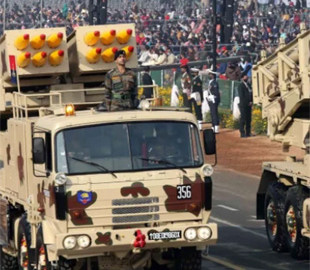
According to information published by the Indian news agency Asian News International (ANI) on November 9, 2024, the French Army is actively evaluating India's Pinaka multiple-barreled multiple rocket launcher (MBRL ) for potential integration into your arsenal. A senior French army officer said the Pinak system, developed by India's Defense Research and Development Organization (DRDO), could meet France's specific tactical needs, especially in terms of mobility and rapid strike.
Brigadier General Stéphane Richou of the French Army confirmed to ANI (Asian News International) that France is considering the Pinaka MBRL as part of a wider evaluation involving the world's best reactive artillery systems.
Developed by the Indian Defense Research and Development Organization (DRDO), the Pinaka Multi-Barrel Rocket Launcher (MBRL) is a highly versatile mobile artillery system designed for rapid and reliable fire support. It is used primarily for bombing, targeting enemy positions, infrastructure, and personnel concentrations with impressive accuracy and range. Since its introduction, the Pinaka has improved significantly, with variants appearing that improve its range, accuracy and payload capabilities, making it an effective tool in modern warfare.
The initial variant, the Pinaka Mk-I, has a range of up to 40 kilometers and is equipped with various warheads. It can produce high-explosive (HE) projectiles for large-scale explosive effects and fragmentation, effective against personnel and lightly fortified structures. The Mk-I also supports anti-tank mine rounds, creating defensive perimeters and disrupting enemy armor. Additionally, it can launch incendiary warheads designed to ignite fuel or other flammable targets, making it versatile in both offensive and defensive missions. Each Mk-I missile carries approximately 100 kilograms of explosives, allowing fire to be concentrated in target areas.
To meet the demand for longer range, the Pinaka Mk-II variant extends the operating range of the system to 60-75 kilometers. The Mk-II retains the variety of warheads used in the Mk-I, but adds precision targeting capabilities, increasing its accuracy and making it highly effective in scenarios where controlled, targeted strikes are required. Thanks to GPS and an Inertial Navigation System (INS), the Mk-II can deliver payloads with increased precision, providing greater efficiency and reducing collateral damage on the battlefield.
200% Deposit Bonus up to €3,000 180% First Deposit Bonus up to $20,000The Pinaka's guided missile variant is another leap forward in the Pinaka's capabilities, including advanced guidance systems that make it very suitable for precision combat. With a range of up to 75 kilometers, it uses a combination of INS and GPS to engage critical targets with minimal error. This variant is particularly effective against fortified structures, command centers, and other strategic assets, making it a valuable tool for targeting operations that require high precision.
Pinaka Area Denial Munition (ADM) missiles are designed to prevent enemy movement through designated areas for area closure missions. Equipped with cluster munitions, these missiles scatter numerous submunitions over a large area, effectively neutralizing personnel and light equipment. In addition, anti-tank and anti-personnel minelaying missiles create temporary minefields that act as deterrents, making the ADM option essential in scenarios where halting an enemy advance is critical.
To further expand the Pinaka's capabilities, the Extended Range Guided Pinaka (ER-Pinaka) is currently under development with a projected range of up to 90 kilometers. This upcoming variant aims to deliver the same high accuracy at longer ranges, increasing the platform's flexibility and making it one of the most adaptable artillery systems in the Indian Army's arsenal.
The Pinaka's ability to switch between different missile types provides exceptional adaptability on the battlefield. Mounted on a high mobility vehicle, it can fire a full salvo of 12 missiles within 44 seconds and move immediately to avoid counterattacks. This mobility, combined with a powerful array of missile options, has made the Pinaka the preferred artillery choice for the Indian Army and a strong candidate for international defense cooperation.
India and France have a long-standing and robust defense partnership marked by high-level cooperation, transfer technologies and joint military exercises. This partnership has strengthened significantly in recent years with key acquisitions such as India's purchase of 36 Rafale fighter jets from France's Dassault Aviation and increased cooperation in advanced defense technology. The two countries conduct regular joint military exercises, including the Garuda and Varun exercises, increasing interoperability between their armed forces.

